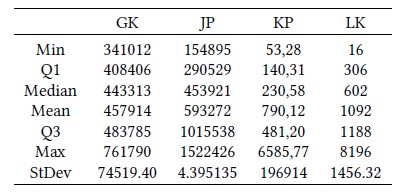Robust Panel Data Regression Analysis using the Least Trimmed Squares (LTS) Estimator on Poverty Line Data in Lampung Province
Main Article Content
Abstract
Robust regression is an alternative method in regression analysis designed to produce stable parameter estimates, even when the data contain outliers or deviate from classical assumptions. One of its estimation techniques, the Least Trimmed Square (LTS),works by minimizing the smallest squared residuals, thereby assigning smaller weights to extreme data points. This method serves as a solution when classical approaches, such as Ordinary Least Squares (OLS), fail to meet the assumptions, especially in socio-economic data that are often complex and prone to outliers. This study employs robust regression with the LTS estimator on panel data to examine the impact of population size , population density , and registered job vacancies on poverty lines in Lampung Province. The data cover 15 districts and cities from 2019 to 2023. The analysis results show that the model obtained has a coefficient of determination of R2=0.8909. This means that the three predictor variables can explain 89.09% of the variation in the poverty line.
Article Details
References
[1] D. C. Montgomery, E. A. Peck, and G. G. Vining. Introduction to Linear Regression Analysis. John Wiley & Sons Inc., 2012.
[2] S. Shoukat, S. Nawaz, M. M. Rasheed, A. Javaid, and H. A. Sami. Efficiency of ols and huber m estimator in case of outliers. Journal of Excellence in Social Sciences, 3(3):55–60, 2024.
[3] D. N. Gujarati and D. C. Porter. Basic Econometrics. McGraw-Hill Education, 2009.
[4] B. D. Baltagi. Econometric Analysis of Panel Data. John Wiley & Sons Ltd, 2005.
[5] C. Hsiao. Analysis of Panel Data. Cambridge University Press, 4 edition, 2024.
[6] I. P. Hutagalung and O. Darnius. Analisis regresi data panel dengan pendekatan common effect model (cem), fixed effect model (fem) dan random effect model (rem) (studi kasus: Ipm sumatera utara periode 2014–2020). FARABI: Jurnal Matematika Dan Pendidikan Matematika, 5(2):217–226 (in Indonesia), 2022.
[7] N. A. Salsabila, H. K. Juliarto, A. F. Syawal, and D. A. Nohe. Analisis regresi data panel pada ketimpangan pendapatan daerah di provinsi kalimantan timur. In Prosiding Seminar Nasional Matematika, Statistika, dan Aplikasinya, volume 2, pages 241–253 (in Indonesia), 2022.
[8] T. S. Edriani, A. Rahmadani, and D. M. M. Noor. Analisis hubungan kepadatan penduduk dengan pola penyebaran covid-19 provinsi dki jakarta menggunakan regresi robust. Indonesian Journal of Applied Mathematics, 1:51–60 (in Indonesia), 2021.
[9] R. Yousuf and M. Sharma. Applications of mitscherlich baule function: A robust regression approach. Research in Statistics, 2(1):1–5, 2024.
[10] D. M. Khan, A. Yaqoob, S. Zubair, M. A. Khan, Z. Ahmad, and O. A. Alamri. Applications of robust regression techniques: An econometric approach. Mathematical Problems in Engineering, 2021:1–9, 2021.
[11] A. Husain and S. R. W. Jamaluddin. Pemodelan data angka kematian bayi menggunakan regresi robust. SAINTEK: Jurnal Sains, Teknologi & Komputer, 1:1–7 (in Indonesia), 2023.
[12] R. Aristiarto, Y. Susanti, and I. Susanto. Analisis regresi robust estimasi gm pada indeks keparahan kemiskinan provinsi-provinsi di indonesia. In Seminar Nasional Riset dan Inovasi Teknologi (SEMNAS RISTEK), volume 7, pages 205–209 (in Indonesia), 2023.
[13] I. A. Azzahro and A. Sofro. Regresi robust untuk pemodelan deforestasi di indonesia. MATHunesa: Jurnal Ilmiah Matematika, 2(3):496–507 (in Indonesia), 2023.
[14] E. Setyowati, R. Akbarita, and R. R. Robby. Perbandingan regresi robust metode least trimmed square (lts) dan metode estimasi-s pada produksi padi di kabupaten blitar. Jurnal Matematika UNAND, 1(3):329–341 (in Indonesia), 2021.
[15] I. R. Akolo and A. Nadjamuddin. Analisis regresi robust estimasi least trimmed square dan estimasi maximum likelihood pada pemodelan ipm di pulau sulawesi. Euler: Jurnal Ilmiah Matematika, Sains, dan Teknologi, 10(2):211–221 (in Indonesia), 2022.
[16] P. Anggun, Sugito, and H. Yasin. Pemodelan regresi ridge robust s, m, mm-estimator dalam penanganan multikolinearitas dan pencilan. Jurnal Gaussian, 10(3):402–412 (in Indonesia), 2021.
[17] Y. N. Sari, R. R. Robby, R. Akbarita, and R. Narendra. Perbandingan analisis regresi quantil dan robust least trimmed square (lts) untuk mengidentifikasi faktor-faktor yang mempengaruhi penyebaran penyakit malaria di jawa timur. In Prosiding Seminar Nasional Universitas Insan Budi Utomo, volume 5, pages 182–193 (in Indonesia), 2024.
[18] A. F. Muamalah, P. T. B. Ngastiti, and A. Isro’il. Perbandingan hasil model regresi robust estimasi m (method of moment), estimasi m (maximum likelihood type), dan estimasi lts (least trimmed square) pada produksi padi di kecamatan sekaran. MATHunesa: Jurnal Ilmiah Matematika, 12(3):540–548 (in Indonesia), 2024.
[19] W. O. Amni, A. K. Jaya, and Nirwan. Perbandingan analisis komponen utama robust minimum covarian determinant dengan least trimmed square pada data produk domestik regional bruto. ESTIMASI: Journal of Statistics and Its Application, 5(2):266–281 (in Indonesia), 2024.
[20] T. W. Nurmulyati, D. Permana, N. Amalita, and Z. Martha. Comparison of estimate method of moment and least trimmed squares in models robust regression. UNP Journal of Statistics and Data Science, 2(2):204–248, 2024.
[21] T. E. Lestari and R. D. T. Yuansa. Response surface regression with lts and mm-estimator to overcome outliers on red roselle flowers. Jurnal VARIAN, 4(2):91–98, 2021.
[22] G. Mardiatmoko. Pentingnya uji asumsi klasik pada analisis regresi linier berganda (studi kasus penyusunan persamaan allometrik kenari muda [Canarium indicum L.]). Barekeng: Jurnal Ilmu Matematika & Terapan, 14(3):333–342 (in Indonesia), 2020.
[23] Michael H. Kutner, Christoper J. Nactsheim, J. Neter, and W. Li. Applied Linear Statistical Models. McGraw-Hill Education, 2004.

